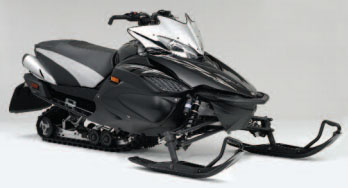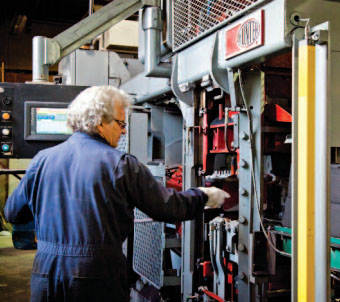Spring 2014: Robertson Review
Casting a Racing Shock System for High Performance Snowmobiles
Download Spring 2014: Robertson Review in PDF
When a leading snowmobile manufacturer asked us to create a component for their nitrogen-energized racing shock system, we began by creating a component that could assure a long life with the material strength to resist the high stresses of a hostile environment. The part also would have to be manufactured with cast aluminum to deliver the lightweight necessary to make the solution practical.
We chose sand casting with a 356.2 Sr aluminum casting alloy heat treated to T6 condition in our heat treatment facilities. Heat treating on site is essential to take advantage of the brief window of opportunity when the cooling part is at the optimum temperature range to be worked. T6 heat treating strengthens the metal by as much as 40% to produce a lightweight component strong enough to withstand the pressures that will be applied to the part during the operation of the end product. The Sr designation indicates a Strontium modification.
After the addition of strontium, the structure of the silicon particles are altered from the normal angular structure to a rounded state. This boost final yield strength also helps improve final pressure tightness. The addition of stress relieving aluminum is essential with large parts or any part where there are thick and thin locations.
Robertson Foundries produced the casting with 100 percent pressure tightness using a 150 psi operating pressure. Machining the heat treated component included the installation of a swivel bearing to meet a .0005 in. fit specification. We also anodized the finished casting.
Our customer benefited with a single source solution responsible for casting, heat treating, tooling, machining and fixture building in house that included the completion of 4,000 sets.
Choosing the Best Casting Process for Your Manufactured Components
We offer a full range of tooling methods to meet your cast component requirements. We make our own match plates and core boxes when a project requires them. Our foundry capabilities include:
- Aluminum foundry casts sizes up to 24” x 24” x 6” and weights up to 30 lb.
- Bronze foundry offers different tooling methods to accommodate a customer’s requirements up to 24” x 24” x 6” and weights up to 100 lb.
Casting Methods for Every Production Need
Robertson Foundries provides the casting methods you need to complete a quality cast component. These include:
- Permanent mold castings can be completed by tilt pour methods using permanent mold or semi-permanent molds in sizes up to 30” x 30” and weights up to 30 lb.
- Aluminum sand castings and bronze sand castings are completed using Hunter matchplate molding,
 roto lift, and jolt squeeze methods in our sand foundry. We complete pre-production and production of sand casting orders as needed in our sand foundry.
roto lift, and jolt squeeze methods in our sand foundry. We complete pre-production and production of sand casting orders as needed in our sand foundry. - Machined aluminum casting can be CMM verified. We complete heat treatment for machined aluminum casting onsite. Alloys used are A356.2, A319.0 and Almag 35. All machined aluminum casting and CMM verification are completed onsite. Robertson Foundries manufactures all machined aluminum castings by sand cast or gravity permanent mold. All machined aluminum processes operate under ISO-9001-2008 quality systems. We produce machined aluminum castings in sizes up to 24” x 24” x 6” and weights up to 30 lb.
- Machined bronze castings include valve works, electrical and fluid handling applications. Many such
 castings are completed as pressure tight finished goods. We complete all bronze melting with induction melting. Robertson Foundries produce machined bronze castings in sizes up to 24” x 24” x 6” and weights up to 100 lb. Machined bronze casting alloys include:
castings are completed as pressure tight finished goods. We complete all bronze melting with induction melting. Robertson Foundries produce machined bronze castings in sizes up to 24” x 24” x 6” and weights up to 100 lb. Machined bronze casting alloys include:
— CDA 81000 Copper Alloy (99.995)
— CDA 83450 “Low Lead” Red Brass
— CDA 83600 Leaded Red Brass
— CDA 84400 Leaded Red Brass
— CDA 86500 Manganese Bronze
— CDA 87500 Silicon Bronze
— CDA C-922 Naval Bronze
— CDA C-952 Aluminum Bronze
Bronze or Brass – Which is Better for Your Metal Casting Applications?
Choosing the right metal requires an understanding of the properties of various metals used in casting. We have the metallurgy expertise to guide you in the selection process. One of the more confusing choices OEMs face is the decision to cast in bronze or brass.
Bronze is a reddish brown alloy of copper and zinc. Brass is a muted yellow copper alloy that looks a lot like gold. It usually contains tin, but other metals such as phosphorus, manganese, aluminum, or silicon may be included. Bronze dates from around 3500 BC while brass wasn’t discovered until about 500 BC.
Brass has a higher malleability than zinc or copper. It has a low melting point at 900 degrees centigrade and flows when melted. In some cases, iron, aluminum, silicon and manganese may be added for corrosion-resistant brass alloys. Brass is susceptible to stress cracking when exposed to ammonia and is not as hard as steel.
Unlike brass, bronze is hard and brittle. It melts at about 950 degrees centigrade but the melt temperature varies depending on the amount of tin included in the alloy. Bronze resists corrosion and is especially corrosion resistant in seawater. It suffers metal fatigue more than steel but is a superior conductor of heat and electricity compared to steel.
We recommend brass for decorative and low-friction applications like locks, gears, doorknobs, ammunition, and valves. Brass also is an excellent choice for plumbing fixtures and electronic components. Brass possesses excellent acoustic properties making it highly desirable for musical instruments. Brass can be found in zippers and anywhere you want to avoid sparks such as tools and fittings used around explosive gas.
Bronze is used to cast boat and ship fittings, propellers and submerged bearings because it resists corrosion because salt water. We also recommend bronze when casting sculpture, bearings, clips, electrical connectors and springs. It’s an excellent choice for bells and cymbals.
All brass and bronzes are suitable for current carrying devices and are used in High and Low voltage applications.
Download Spring 2014: Robertson Review in PDF
